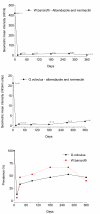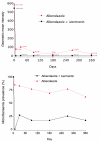Treatment of co-infection with bancroftian filariasis and onchocerciasis: a safety and efficacy study of albendazole with ivermectin compared to treatment of single infection with bancroftian filariasis
- PMID: 14613509
- PMCID: PMC293471
- DOI: 10.1186/1475-2883-2-15
Treatment of co-infection with bancroftian filariasis and onchocerciasis: a safety and efficacy study of albendazole with ivermectin compared to treatment of single infection with bancroftian filariasis
Abstract
BACKGROUND: In order to use a combination of ivermectin and albendazole for the elimination of lymphatic filariasis, it is important to assess the potential risk of increased adverse events in individuals infected with both lymphatic filariasis and onchocerciasis. We compared the safety and efficacy of albendazole (400 mg) in combination with ivermectin (150 micrograms/kg), for the treatment of co-infections of Wuchereria bancrofti and Onchocerca volvulus with single infection of W. bancrofti. METHODS: The safety study on co-infections was a crossover, double blind design, while for the single infection of bancroftian filariasis an open design comparing two treatments was used. For co-infection, one group was allocated a single dose of ivermectin (150 micrograms/kg) plus albendazole (400 mg) (Group A). The other group received placebo (Group B). Five days later the treatment regime was reversed, with the Group A receiving placebo and Group B receiving treatment. For the single bancroftian filariasis infection, one group received a single dose of albendazole (400 mg) plus ivermectin (150 microg/kg) (Group C) while the other group received a single dose of albendazole (400 mg) alone (Group D). Blood and skin specimens were collected on admission day, day 0, and on days 2, 3, and 7 to assess drug safety and efficacy. Thereafter, blood and skin specimens were collected during the 12 months follow up for the assessment of drug efficacy. Study individuals were clinically monitored every six hours during the first 48 hours following treatment, and routine clinical examinations were performed during the hospitalisation period and follow-up. RESULTS: In individuals co-infected with bancroftian filariasis and onchocerciasis, treatment with ivermectin and albendazole was safe and tolerable. Physiological indices showed no differences between groups with co-infection (W. bancrofti and O. volvulus) or single infection (W. bancrofti). The frequency of adverse events in co-infected individuals was 63% (5/8, Group A, albendazole + ivermectin) and 57% (4/7, Group B, placebo) and of mild or moderate intensity. In single W. bancrofti infection the frequency of adverse events was 50% (6/12, Group C, albendazole + ivermectin) and 38% (5/13, Group D, albendazole) and of a similar intensity to those experienced with co-infection. There were no differences in adverse events between treatment groups. There was no significant difference in the reduction of microfilaraemia following treatment with albendazole and ivermectin in groups with single or co-infection. CONCLUSION: Our findings suggest that ivermectin plus albendazole is a safe and tolerable treatment for co-infection of bancroftian filariasis and onchocerciasis.
Figures



References
-
- WHO Global programme to eliminate lymphatic filariasis. WHO/CDS/CPE/CEE/200228. 2002. http://www.filariasis.org
-
- Michael E, Bundy DAP, Grenfell BT. Re-assessing the global prevalence and distribution of lymphatic filariasis. Parasitology. 1996;112:409–428. - PubMed
-
- Maegga BTA. Onchocerciasis. In: Mwaluko GMR, Kilama WL, Mandara MP, Murru M and Macpherson CNL, editor. Health and Disease in Tanzania. London, Harper Collins Academic Press; 1991. pp. 159–176.
-
- McMahon JE, Magayuka SA, Kolstrup N, Mosha FW, Bushrod FM, Abaru DE, Bryan JH. Studies on the transmission and prevalence of Bancroftian filariasis in four coastal villages of Tanzania. Ann Trop Med Parasitol. 1981;75:415–431. - PubMed
LinkOut - more resources
Full Text Sources

